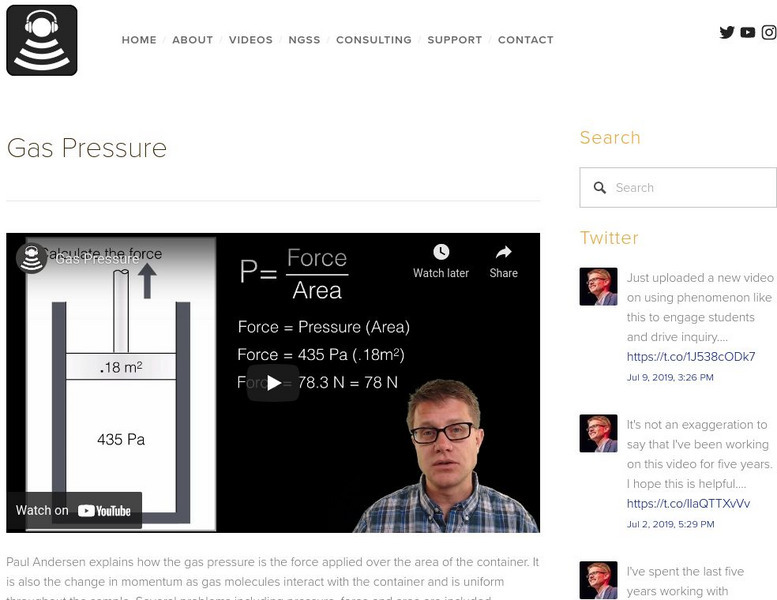PBS
The New Ultimate Energy Limit of the Universe
New ReviewIs there a limit to how much energy you can cram into, or pull out of one patch of space? Well, we thought so, but the James Webb Space Telescope has found a quasar that simultaneously breaks a century-old theoretical limit and may...
Bozeman Science
Gas Pressure
In this video Paul Andersen explains how the gas pressure is the force applied over the area of the container. It is also the change in momentum as gas molecules interact with the container and is uniform throughout the sample. Several...
Curated Video
The Relationship Between Temperature and Gas Pressure in a Container
The video discusses how gas exerts pressure on the walls of its container and how changes in temperature affect that pressure. The video goes on to explain that increasing the temperature of a gas increases the kinetic energy and speed...
Curated Video
Introduction to Gas Pressure and its Relation to Temperature and Volume
This video is a lecture presentation that explains the concept of gas pressure. The presentation then explores how temperature and volume affect gas pressure. The presentation concludes by discussing the balance of forces and pressure...
Visual Learning Systems
Volcanic Eruptions
This video discusses the different factors that can affect the nature of volcanic eruptions. It provides examples of explosive and calmer eruptions, such as the 1991 eruption of Mount Pinatubo in the Philippines and the eruption of Mount...
Socratica
Chemistry: Gay-Lussac's Law (Gas Laws)
If an aerosol can lands in a fire, it explodes due to Gay-Lussac's Law. A video from a chemistry playlist explains Gay-Lussac's Law and the relationship between pressure and temperature of gases. It includes two guided practice problems...
Socratica
Chemistry: Boyle's Law (Gas Laws)
Pressure and volume remain inversely proportional for all gases. Socratica presents a video about this relationship as part of their chemistry playlist. It explains Boyle's Law and the associated formulas before demonstrating the...
Teacher's Pet
Properties of Gases
What makes gases so unique? Physical science sleuths uncover the facts about gases in a short video. The narrator compares gases to solids and liquids in terms of space between particles, compressibility, and reaction to temperature...
Fuse School
Rates of Reactions—Part 2
Learners examine the factors that affect reaction rates in the sixth lesson in a 35-part video series. The video instructor explains the different factors that change reaction rates, and the connection between volume, pressure, and...
Educreations
The Gas Laws
Temperature, pressure, and volume, oh my! Learn how one quality of gas affects the others with a video that includes worked out problems that use the Gas Laws with solutions.
Crash Course
Partial Pressures & Vapor Pressure: Crash Course
How much pressure is exerted by the mixture of gases in a scuba tank? Introduce pupils to Dalton's Law of Partial Pressure and vapor pressure in the video sure to interest the class. The video also reminds viewers that gases are not...
Crash Course
The Ideal Gas Law
Can you crush a soda can using only the air around you? Use an engaging video to teach about the relationship between pressure, volume, moles, and temperature of a given gas, all done with the Ideal Gas Law.
Be Smart
The REAL Physics of Hot Air Balloons!
Up, up, and away! Teach your class the science behind hot air balloons when by showing them the short video segment describing the physics of how they remain in the air and travel distances through different atmospheric...
TED-Ed
The Effects of Underwater Pressure on the Body
Exactly what causes the the pain you feel when diving to the deep end of a pool? Find out with this short video that explores the physical laws governing the behavior of gases and the ways they affect marine life...
Educreations
The Ideal Gas Law
Help young scientists connect the dots between pressure, temperature, and volume with a video on the ideal gas law. After first reviewing the formula for this fundamental law, the instructor walks step by step through nine different...
Science for Kids
Science Kids: Chemistry Video: Gas Basics Video
Learn the basics of gas and pressure. [3:22]
Bozeman Science
Bozeman Science: Gas Pressure
In the following video Paul Andersen explains how the gas pressure is the force applied over the area of the container. It is also the change in momentum as gas molecules interact with the container and is uniform throughout the sample....
National Science Foundation
National Science Foundation: Science of Speed: Tires and Pressure
Tires on a car in a NASCAR race are filled with nitrogen. The force of friction increases tire pressure as the car goes around the track. Using dry nitrogen gas helps with predicting the temperature and pressure of a tire during a race....
Khan Academy
Khan Academy: Gas Exchange: Henry's Law
Explores the relationship between partial pressure of a gas and the concentration of the gas molecule within a liquid. [8:39]
Sophia Learning
Sophia: Gas Pressure
Through this video lesson, learn how to define gas pressure as the collisions of particles of a gas on the sides of its container. [7:08]
Sophia Learning
Sophia: Gas Pressure: Lesson 2
This lesson will define gas pressure as the collisions of particles of a gas on the sides of its container and demonstrate how to convert between common gas pressure units. It is 2 of 2 in the series titled "Gas Pressure."
















